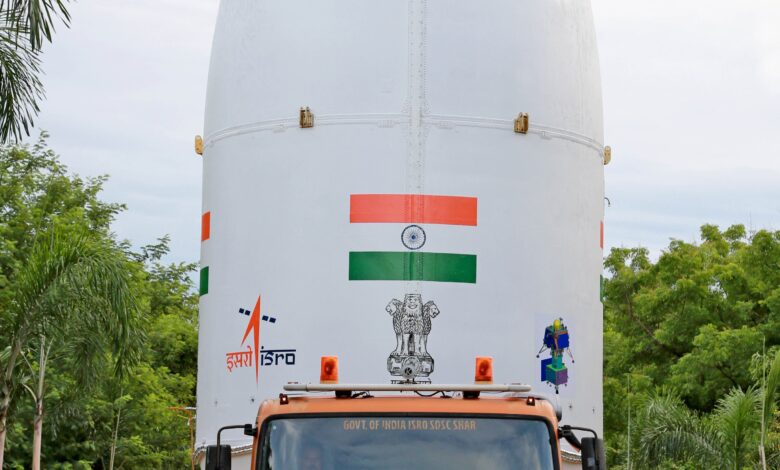ISRO’s Chandrayaan-3 Mission Set for July 14 Launch, Aiming to Showcase Lunar Landing and Roving Capabilities

Indian Space Research Organisation (ISRO) is all set to embark on the highly anticipated Chandrayaan-3 mission, the successor to Chandrayaan-2, with the primary objective of demonstrating safe landing and roving capabilities on the lunar surface. The upcoming mission comprises a Lander and Rover configuration, both equipped with scientific payloads to conduct in-situ experiments on the lunar terrain. The launch is scheduled to take place on July 14 from SDSC SHAR, Sriharikota, using the LVM3 launch vehicle.
The propulsion module of Chandrayaan-3 will carry the Lander and Rover configuration until it reaches a lunar orbit of 100 km. Notably, the propulsion module is equipped with the Spectro-polarimetry of Habitable Planet Earth (SHAPE) payload, designed to conduct spectral and polarimetric measurements of Earth from the lunar orbit.
The Lander payloads on Chandrayaan-3 encompass a range of scientific instruments. These include Chandra’s Surface Thermophysical Experiment (ChaSTE), which aims to measure thermal conductivity and temperature on the lunar surface. The Instrument for Lunar Seismic Activity (ILSA) will measure seismicity around the landing site, while the Langmuir Probe (LP) will estimate plasma density and its variations. Additionally, a passive Laser Retroreflector Array provided by NASA will be utilized for lunar laser ranging studies.
The Rover payloads on Chandrayaan-3 consist of the Alpha Particle X-ray Spectrometer (APXS) and the Laser Induced Breakdown Spectroscope (LIBS). These instruments will play a crucial role in deriving the elemental composition of the lunar surface in the vicinity of the landing site.
Chandrayaan-3, comprising an indigenous Lander module (LM), Propulsion module (PM), and a Rover, aims to develop and demonstrate new technologies essential for future interplanetary missions. The Lander possesses the capability for soft landing at a predetermined lunar site and will deploy the Rover, which will conduct in-situ chemical analysis of the lunar surface during its mobility. The Propulsion Module will primarily facilitate the transportation of the Lander from the launch vehicle injection to the final lunar orbit of 100 km before separating from the Lander Module. In addition to its primary function, the Propulsion Module also carries a scientific payload, operated post-separation of the Lander Module. The GSLV-Mk3 launcher has been identified for the Chandrayaan-3 mission, with plans to place the integrated module in an Elliptic Parking Orbit (EPO) measuring approximately 170 x 36,500 km.
The objectives of the Chandrayaan-3 mission are as follows: to demonstrate safe and soft landing on the lunar surface, to showcase Rover roving capabilities on the Moon, and to conduct in-situ scientific experiments. To achieve these goals, the Lander incorporates several advanced technologies, including laser and RF-based altimeters for altitude measurement, laser Doppler velocimeter and Lander Horizontal Velocity Camera for velocity measurement, laser gyro-based inertial referencing and accelerometer package for inertial measurement, 800N throttleable liquid engines, 58N attitude thrusters, and throttleable engine control electronics for propulsion, powered descent trajectory design and associated software elements for navigation, guidance, and control (NGC), Lander Hazard Detection & Avoidance Camera and Processing Algorithm for hazard detection and avoidance, and a landing leg mechanism.
ISRO has conducted several successful special tests on Earth to demonstrate the advanced technologies employed in the Lander. These tests include the Integrated Cold Test, which assessed integrated sensor and navigation performance using a helicopter as a test platform, the Integrated Hot Test, which evaluated closedloop performance with sensors, actuators, and NGC using a tower crane as a test platform, and the Lander Leg mechanism performance test on a lunar simulant test bed, simulating various touch-down conditions.
With the upcoming launch of Chandrayaan-3, ISRO aims to make significant strides in lunar exploration, showcasing India’s prowess in space technology and advancing our understanding of the Moon. The mission’s focus on safe landing, roving capabilities, and scientific experiments holds immense potential for future interplanetary missions and scientific discoveries. As the countdown begins for the July 13 launch, anticipation and excitement build, marking another remarkable milestone in India’s space exploration journey.




